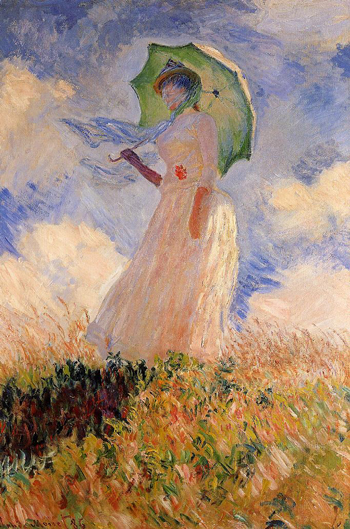
Woman with Parasol (facing left)

|
This was painted during a rather unusual period of Monet's career. For a long time, he had completely abandoned figure painting (something he had attempted only briefly at the beginning of his career). Then, quite suddenly, in 1885, Monet started to work on the relationship of figures to landscape. This period was to be the last time Monet focused on the human figure.
Despite the fact that the woman is clearly the subject of this painting, she is paradoxically obscured. The title, for example, gives us no information about her whatsoever. There is no story, no background, no hint of character with which to contextualize the image on the canvas. The woman's face is a mere blur, with no real discernible features or expression. Her total anonymity is even stranger considering she was dear to Monet: at the time, he was living with Alice Hoschedé, who later became his second wife, and the model for this painting was her then-18-year-old daughter, Suzanne.
She is further depersonalized by the way she is perfectly complimentary to the landscape. Her dress, in concert with the bending plants at her feet, indicates the direction of the wind; she is also in step with the movement of the clouds in the background. The play of light and shadow created by the parasol (beautifully rendered by Monet) serves primarily as an exposition of the soft, supple, sunlight that illuminates the scene.
Though something of an aberration in terms of his career, Monet's isolated later detour into figure painting, and especially this painting in particular, shows the artist's increasing preoccupation with formal values (i.e., the very matter-of-fact title), questions of composition, balance, harmony, and color above other concerns.












